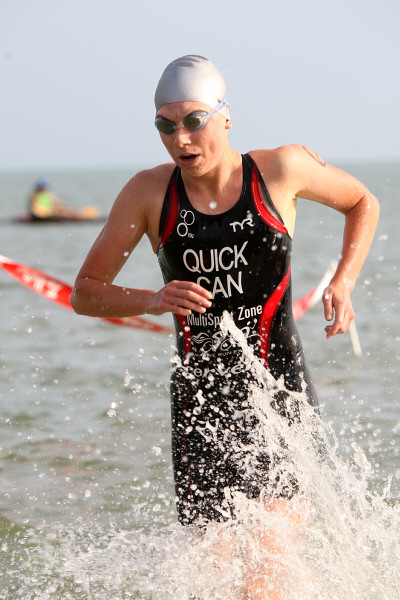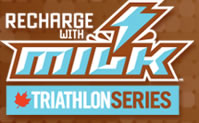How to Make the Most of Your Pool Time?
By Angela Quick
 Most triathletes have limited time to train due to juggling family and work commitments as well as trying to balance and refine three demanding sports simultaneously. Bike and run workouts are easier to fit into a hectic schedule as they require less planning to incorporate them into your day. Unlike running, where you can just slip on your running shoes and hit the pavement virtually anywhere, finding and getting to a pool can be more challenging. Here are my tips on how to use that valuable swim time most effectively. Improving your swim times really comes down to having good and effective technique, reducing drag in the water and increasing endurance and strength.
Most triathletes have limited time to train due to juggling family and work commitments as well as trying to balance and refine three demanding sports simultaneously. Bike and run workouts are easier to fit into a hectic schedule as they require less planning to incorporate them into your day. Unlike running, where you can just slip on your running shoes and hit the pavement virtually anywhere, finding and getting to a pool can be more challenging. Here are my tips on how to use that valuable swim time most effectively. Improving your swim times really comes down to having good and effective technique, reducing drag in the water and increasing endurance and strength.
Technique: It’s all about the catch & body position
There are plenty of resources available thoroughly demonstrating proper swim techniques. Efficient swim technique boils down to having a proficient catch and a proper body position.
‘The catch’ is the portion of the swim stroke that propels you forwards in the water. Having a proficient catch is achievable by having a high vertical forearm in the water creating a higher leveraged arm for propulsion. A cue to enhance high vertical forearm catch in the water is to focus on always having your fingertips point towards the bottom of the pool throughout the entire underwater phase, all while maintaining a high elbow. Shoulder flexibility can restrict this motion and limit how early your catch can begin after hand entry into the water. Other limitations include, having insufficient body rotation which can cause shorting of the catch phase, and one must be beware not to crossover the body’s centerline as it increases drag and disrupts the catch phase.
In order to have an efficient catch, you must have an effective body position in the water. This can be achieved by engaging your core, pressing your chest down into the water and avoiding lifting your head to breathe (keep your head inline with your spine); limiting leg drop in the water and achieving a neutral spine position. Exhale underwater and rotate to take a breath, (but do not over-rotate past the 45-degree mark), to ensure your head maintains a neutral position. Kick and roll from your hips, with a low amplitude kick. All this in turn supports a proper body position in the water and limits drag.
Taking video footage of yourself swimming can be a valuable measure to gauge what areas of your swim stroke you can work to improve.
Drills don’t take the place of ‘actual’ swimming
While technique is a very prominent aspect of becoming a more sufficient swimmer; drills don’t take the place of actual swimming. It is important to obtain good form and build correct muscle memory but swim volume is required to increase strength and power. Drills have their place but do not make it a substitute for swim volume and intensity.
Find your speed & learn how to swim hard!
Just like training for the bike and run aspects of a triathlon, learning to swim fast requires learning how to swim hard. Avoid hopping in the pool to swim repetitive laps; instead incorporate variety into your swim workouts through varying interval distance, pace and rest intervals. Add variety to gain gears and to become comfortable with discomfort. Work on increasing your turnover or strokes per minute to increase speed.
Many triathletes have been accustomed to sprinting off the start line during a race to obtain clear water and with the hopes of being able to catch the draft of faster swimmer’s feet. This sprint speed needs to be trained, as during a race you need to be able to recover from the opening sprint effort and settle into a strong pace for the remainder of the swim portion.
Get out in the open water
There is no better way to prepare for the open water and settle your swim nerves than to train in the same conditions that you will likely be racing in. Pools are very structured and controlled environments; unlike in the open water you have walls to push-off of, lane lines to limit waves and choppiness and black lines to follow as opposed to having to sight for swim buoys. Not to mention the swimmer body contact that can occur during a race. There is no better preparation for these conditions than testing the waters yourself. Find a buddy or a group to practice swimming open water; simulating race starts as a group can help calm your nerves on the starting line as you become more familiar with the body contact experienced at the start. Working on sighting for landmarks and drafting off the feet of other swimmers can help you navigate the swim course on race day more quickly. Everyone in the race will experience the same water conditions as you but the more familiar and competent you can be in the open water can give you an edge over the competition.
Angela Quick is a member of the 2014 Recharge With Milk Triathlon Series Ambassador Team. Angela is often one of the first athletes out of the water in any race she competes in.

